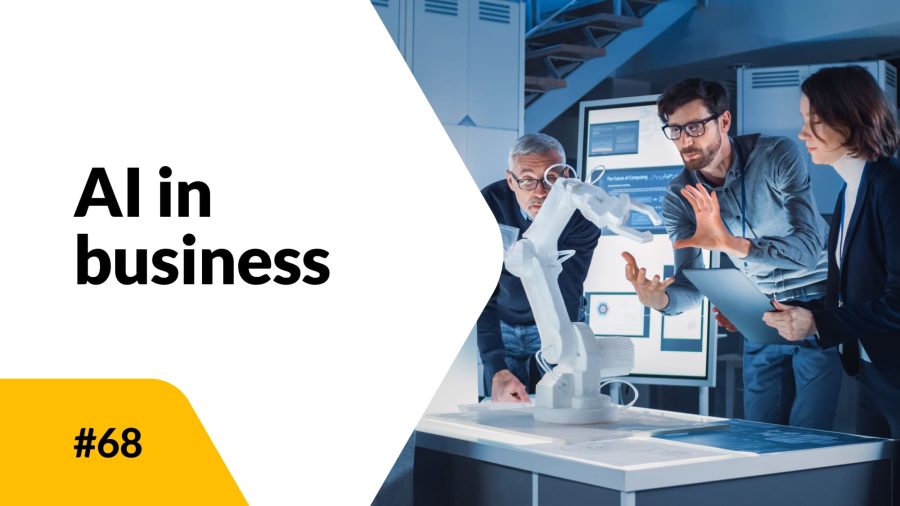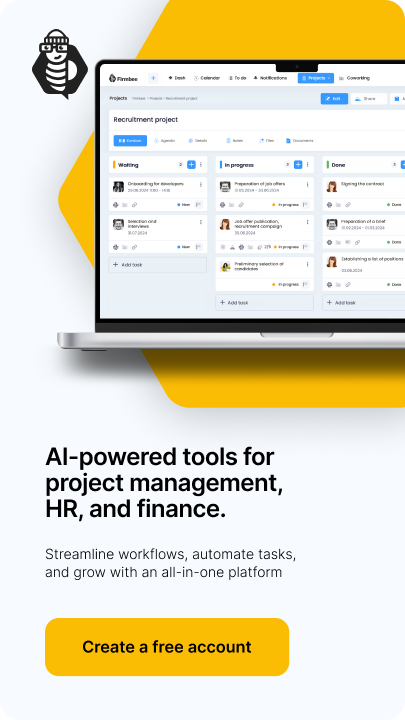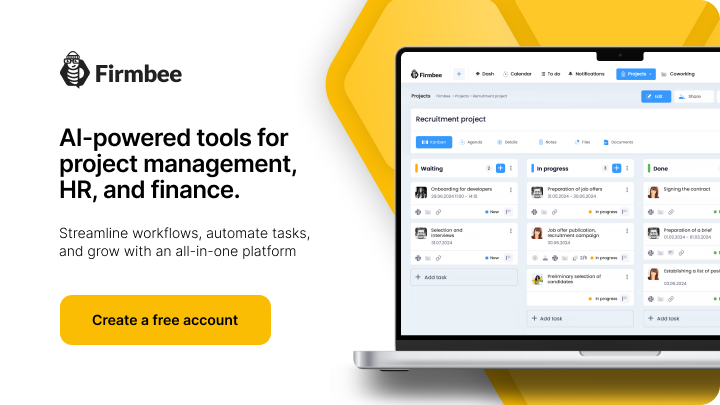The UE AI Act - table of contents
- What is the AI Act, and why is it important for SMEs (small and medium-sized enterprises)?
- Key aspects of the AI Act for business
- Risk levels of AI systems according to the EU AI Act
- What requirements does the AI Act impose on solutions used by my company?
- What will be the consequences of not complying with the AI Act?
- How to get ready for the AI Act taking effect?
- Summary
What is the AI Act, and why is it important for SMEs (small and medium-sized enterprises)?
The AI Act is the first regulation of its kind in the world. The first to comprehensively address artificial intelligence from a human-centric approach to AI. It aims to ensure that AI systems used in Europe are safe and stimulate innovation, while respecting fundamental rights, with a special focus on:
- healthcare – for example, respecting the privacy of patient data,
- education – adhering to values promoted by the European Union and avoiding discrimination,
- border protection – ensuring safety without violating citizens’ rights,
- public services – following best practices in data protection, the right to information, and clear communication.
For SMEs, the AI Act will primarily bring greater legal certainty as it clearly defines the framework for innovation: the principles of designing, developing, and applying AI systems. It will make it easier for companies to invest in AI-based solutions, reducing legal risks. Additionally, regulations applicable across the entire Union will prevent market fragmentation.
European regulations on artificial intelligence were adopted by the European Parliament and the Council of Europe on December 9, 2023. Now, they must be formally accepted by both institutions to come into effect.
Key aspects of the AI Act for business
The EU AI Act introduces a set of requirements for AI systems, depending on the level of risk. These requirements include, among others:
- the obligation of transparency and notifying users in the case of interactions with chatbots, biometric systems, or emotion recognition technologies,
- prohibition of using sensitive attributes for biometric categorization,
- mandatory compliance assessment before market entry for high-risk systems,
- mandatory registration in the EU database — after the AI Act comes into effect, AI systems used in key sectors such as education, employment, healthcare, and law enforcement will be required to be registered.
Manufacturers and companies using AI systems will also be obligated to monitor risks after introducing them to the market. This will directly impact companies designing and implementing AI systems.
Risk levels of AI systems according to the EU AI Act
The AI Act classifies AI systems into four categories based on their level of risk:
- Unacceptable risk
- High risk
- Limited risk
- Minimal risk
Let’s take a closer look at how each group will be defined, along with examples of systems and their classifications.
Unacceptable risk
The European Union imposes a complete ban on the use of technologies listed in the AI Act as systems of unacceptable risk. These are mainly systems designed to exploit individuals’ susceptibility to suggestion for manipulation or deception, systems giving artificial intelligence the ability to make decisions in crucial matters, and those that could lead to an abuse of power. Examples of AI of unacceptable risk include:
- autonomous weapons operating without human supervision,
- credibility assessment systems used by law enforcement agencies,
- automatic identification systems of individuals in public spaces, such as those based on surveillance camera footage,
- artificial intelligence systems that may be harmful to individuals with physical or mental disabilities,
- AI employed for law enforcement purposes, with limited exceptions,
- artificial intelligence systems utilizing harmful “subliminal” and manipulative techniques.
For businesses, the last category is particularly important. This is why transparency in the operation of systems providing suggestions to users and customers will be crucial for compliance with the new legislation of the European Union.
High risk
Artificial intelligence classified as a high-risk AI solution will have to meet rigorous requirements before entering the market. This involves compliance assessments and strict testing before being approved for use. This risk category includes eight areas, such as:
- autonomous vehicles,
- medical diagnostic systems,
- predictive algorithms supporting the justice system,
- migration and asylum management, border control, as well as
- employment and workforce management.
Limited risk
To limited-risk systems, most commonly used in business, legislators have fortunately paid much less attention. This category includes:
- AI chatbots – used for customer service or responding to frequently asked questions in the form of free-flowing conversation,
- emotion recognition systems – used, for example, to gather data on customer opinions about a company,
- biometric categorization systems – such as assessing the gender or age of customers in a physical store,
- image, audio, or video generation – despite the threat posed by deep fakes, this area will be subject to a limited set of obligations.
Low or minimal risk
Low-risk AI solutions are not subject to legal regulations. The AI Act will only mention that creators and users of such solutions should voluntarily establish usage policies. This pertains to solutions such as:
- content recommendation systems in streaming services, or
- chatbots on websites responding to typical customer questions.
What requirements does the AI Act impose on solutions used by my company?
To check if the artificial intelligence used by a company complies with the AI Act, you should:
- classify it into one of the four risk categories described above,
- if it’s AI of high risk, conduct a compliance assessment,
- use good practices regarding low-risk AI.
Let’s look at examples of frequently used AI solutions by companies. What requirements will they have to meet?
A customer service chatbot providing basic information about products or answering typical customer questions will likely be classified as a minimal-risk system. It will need to:
- inform users that they are interacting with AI,
- provide the option to be redirected to a human consultant,
- adhere to general requirements regarding transparency, non-discrimination, etc.
A product recommendation system in e-commerce will likely be considered a low-risk system. It will be necessary to inform customers that they are receiving personalized recommendations and provide the option to disable them.
On the other hand, a system for automatic medical diagnostics will be classified as a high-risk system. It will need to undergo a rigorous assessment before market entry and be supervised by a human. Additionally, monitoring its operation and reporting incidents will be necessary.
The urban crime prevention system will also be considered high-risk. It will have to comply with regulations on the protection of privacy and other fundamental rights. Its operation will have to be under constant human supervision.
It is unclear into which category AI-based decision-making systems will fall. It is likely that an AI-based recruitment system that makes hiring decisions on its own will be considered an AI solution of unacceptable risk. On the other hand, a recruitment support system that helps people do their jobs would be considered a high-risk solution.
For the sake of users’ welfare, as well as possible changes in classifications, it is very important to approach the construction and use of AI systems in an ethical and responsible manner from the outset.
What will be the consequences of not complying with the AI Act?
Not following the AI Act could lead to significant fines for companies, ranging from €35 million or 7% of global turnover for large enterprises to €7.5 million or 1.5% for SMEs. Unlawful AI systems might be taken off the market, and their use could be limited.
How to get ready for the AI Act taking effect?
So how do you prepare a company that uses artificial intelligence for the AI Act coming into effect in 2025? Here are some tips on how SMEs and startups can prepare for this moment:
- keep abreast of the progress of the work and the timeline for implementation of the regulations,
- evaluate AI systems already in use and adapt them to the new requirements,
- pay particular attention to ethical aspects in the design of AI.
Summary
The introduction of the AI Act is a big change for the AI ecosystem in Europe. However, with clear and consistent rules, it promises to ensure the safe and ethical development of this technology, which should benefit SMEs and start-ups in particular.
The AI Act, which will come into effect in 2025, will bring significant changes in how small and medium-sized enterprises (SMEs) can leverage artificial intelligence. For SMEs, this primarily means the necessity of careful consideration and analysis of the AI solutions they use, both in terms of compliance with regulations and potential impact on customers and the community.
For small business owners and managers, it’s essential to grasp how their AI systems are categorized in terms of risk and what actions are needed to align them with the upcoming regulations. Take, for example, AI systems used in customer management or marketing, which were previously used quite freely. Now, they’ll require a thorough analysis for compliance with the AI Act. This could create new opportunities for firms specializing in tech legal advice, providing SMEs with support in adapting to these new requirements.

If you like our content, join our busy bees community on Facebook, Twitter, LinkedIn, Instagram, YouTube, Pinterest, TikTok.
Author: Robert Whitney
JavaScript expert and instructor who coaches IT departments. His main goal is to up-level team productivity by teaching others how to effectively cooperate while coding.
AI in business:
- Threats and opportunities of AI in business (part 1)
- Threats and opportunities of AI in business (part 2)
- AI applications in business - overview
- AI-assisted text chatbots
- Business NLP today and tomorrow
- The role of AI in business decision-making
- Scheduling social media posts. How can AI help?
- Automated social media posts
- New services and products operating with AI
- What are the weaknesses of my business idea? A brainstorming session with ChatGPT
- Using ChatGPT in business
- Synthetic actors. Top 3 AI video generators
- 3 useful AI graphic design tools. Generative AI in business
- 3 awesome AI writers you must try out today
- Exploring the power of AI in music creation
- Navigating new business opportunities with ChatGPT-4
- AI tools for the manager
- 6 awesome ChatGTP plugins that will make your life easier
- 3 grafików AI. Generatywna sztuczna inteligencja dla biznesu
- What is the future of AI according to McKinsey Global Institute?
- Artificial intelligence in business - Introduction
- What is NLP, or natural language processing in business
- Automatic document processing
- Google Translate vs DeepL. 5 applications of machine translation for business
- The operation and business applications of voicebots
- Virtual assistant technology, or how to talk to AI?
- What is Business Intelligence?
- Will artificial intelligence replace business analysts?
- How can artificial intelligence help with BPM?
- AI and social media – what do they say about us?
- Artificial intelligence in content management
- Creative AI of today and tomorrow
- Multimodal AI and its applications in business
- New interactions. How is AI changing the way we operate devices?
- RPA and APIs in a digital company
- The future job market and upcoming professions
- AI in EdTech. 3 examples of companies that used the potential of artificial intelligence
- Artificial intelligence and the environment. 3 AI solutions to help you build a sustainable business
- AI content detectors. Are they worth it?
- ChatGPT vs Bard vs Bing. Which AI chatbot is leading the race?
- Is chatbot AI a competitor to Google search?
- Effective ChatGPT Prompts for HR and Recruitment
- Prompt engineering. What does a prompt engineer do?
- AI Mockup generator. Top 4 tools
- AI and what else? Top technology trends for business in 2024
- AI and business ethics. Why you should invest in ethical solutions
- Meta AI. What should you know about Facebook and Instagram's AI-supported features?
- AI regulation. What do you need to know as an entrepreneur?
- 5 new uses of AI in business
- AI products and projects - how are they different from others?
- AI-assisted process automation. Where to start?
- How do you match an AI solution to a business problem?
- AI as an expert on your team
- AI team vs. division of roles
- How to choose a career field in AI?
- Is it always worth it to add artificial intelligence to the product development process?
- AI in HR: How recruitment automation affects HR and team development
- 6 most interesting AI tools in 2023
- 6 biggest business mishaps caused by AI
- What is the company's AI maturity analysis?
- AI for B2B personalization
- ChatGPT use cases. 18 examples of how to improve your business with ChatGPT in 2024
- Microlearning. A quick way to get new skills
- The most interesting AI implementations in companies in 2024
- What do artificial intelligence specialists do?
- What challenges does the AI project bring?
- Top 8 AI tools for business in 2024
- AI in CRM. What does AI change in CRM tools?
- The UE AI Act. How does Europe regulate the use of artificial intelligence
- Sora. How will realistic videos from OpenAI change business?
- Top 7 AI website builders
- No-code tools and AI innovations
- How much does using AI increase the productivity of your team?
- How to use ChatGTP for market research?
- How to broaden the reach of your AI marketing campaign?
- "We are all developers". How can citizen developers help your company?
- AI in transportation and logistics
- What business pain points can AI fix?
- Artificial intelligence in the media
- AI in banking and finance. Stripe, Monzo, and Grab
- AI in the travel industry
- How AI is fostering the birth of new technologies
- The revolution of AI in social media
- AI in e-commerce. Overview of global leaders
- Top 4 AI image creation tools
- Top 5 AI tools for data analysis
- AI strategy in your company - how to build it?
- Best AI courses – 6 awesome recommendations
- Optimizing social media listening with AI tools
- IoT + AI, or how to reduce energy costs in a company
- AI in logistics. 5 best tools
- GPT Store – an overview of the most interesting GPTs for business
- LLM, GPT, RAG... What do AI acronyms mean?
- AI robots – the future or present of business?
- What is the cost of implementing AI in a company?
- How can AI help in a freelancer’s career?
- Automating work and increasing productivity. A guide to AI for freelancers
- AI for startups – best tools
- Building a website with AI
- OpenAI, Midjourney, Anthropic, Hugging Face. Who is who in the world of AI?
- Eleven Labs and what else? The most promising AI startups
- Synthetic data and its importance for the development of your business
- Top AI search engines. Where to look for AI tools?
- Video AI. The latest AI video generators
- AI for managers. How AI can make your job easier
- What’s new in Google Gemini? Everything you need to know
- AI in Poland. Companies, meetings, and conferences
- AI calendar. How to optimize your time in a company?
- AI and the future of work. How to prepare your business for change?
- AI voice cloning for business. How to create personalized voice messages with AI?
- Fact-checking and AI hallucinations
- AI in recruitment – developing recruitment materials step-by-step
- Midjourney v6. Innovations in AI image generation
- AI in SMEs. How can SMEs compete with giants using AI?
- How is AI changing influencer marketing?
- Is AI really a threat to developers? Devin and Microsoft AutoDev
- AI chatbots for e-commerce. Case studies
- Best AI chatbots for ecommerce. Platforms
- How to stay on top of what's going on in the AI world?
- Taming AI. How to take the first steps to apply AI in your business?
- Perplexity, Bing Copilot, or You.com? Comparing AI search engines
- ReALM. A groundbreaking language model from Apple?
- AI experts in Poland
- Google Genie — a generative AI model that creates fully interactive worlds from images
- Automation or augmentation? Two approaches to AI in a company
- LLMOps, or how to effectively manage language models in an organization
- AI video generation. New horizons in video content production for businesses
- Best AI transcription tools. How to transform long recordings into concise summaries?
- Sentiment analysis with AI. How does it help drive change in business?
- The role of AI in content moderation


















